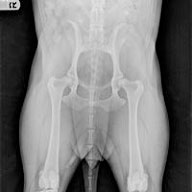PennHIP Screening
![]()
Preventing Osteoarthritis in Dogs
PennHIP screenings can ensure your dog stays happy and healthy as it ages by helping prevent dog degenerative joint disease (also known as osteoarthritis). Learn more below about PennHIP and how we can help your pet maintain a high quality of life.
What is PennHIP Screening?
Keeping Your Dog’s Hips Healthy
Canine hip dysplasia (CHD) is still the most common inherited joint problem in large breed dogs. A PennHIP is a radiographic screening technique to evaluate the laxity (or looseness) in canine hips and determine their risk of developing degenerative joint disease (DJD).
What You Need to Know About PennHIP Screenings
PennHIP FAQ
What are the benefits of PennHIP?
A PennHIP screening is a qualitative measurement of hip joint laxity— so you can be certain in the data it provides. Additionally:
- It is a well-researched, objective method that follows strict scientific protocols and is published in peer-reviewed veterinary literature.
- Veterinarians who wish to submit PennHIP x-rays are required to be trained in the technique and certified, helping ensure accurate data.
- It can help eliminate the hip dysplasia genes out of breeding stock.
- It can be performed on dogs as young as 16 weeks.
- It can be used to test if a dog is a candidate for surgery to prevent DJD.
- It can help assess the usefulness of performing a preventive procedure called Juvenile Pubic Symphysiodesis (JPS), based on the risk of developing hip dysplasia.
Overall, with the information obtained from a PennHIP screening, preventive and palliative strategies can be recommended to treat canine hip dysplasia before it detrimentally impacts a pet’s quality of life.
How is the PennHIP evaluation performed?
While the PennHIP examination is fairly quick, it begins by anesthetizing your dog to allow for complete relaxation and better radiographic positioning. As an outpatient diagnostic procedure, your pet will then go home the same day. During the screening itself, three x-ray views of the hips are taken:
Distraction View
For hip joint laxity

Compression View
For joint hip congruity

Extension View
For osteoarthritis readings

Who can perform a PennHIP exam?
Only veterinarians certified in the PennHIP technique may perform the examination. At Veterinary Surgical Specialists, our surgeon Dr. Diane Craig meets these requirements.
Do I need a referral for a PennHIP screening?
No referral is necessary for PennHIP. We can perform the exam per your request. Please call us at 949.936.0055 or email us at info@vssoc.com for more information and to schedule your dog’s screening.
Why is PennHIP the preferred method of evaluation?
Prior to the development of the PennHIP method, Orthopedic Foundation for Animals (OFA) evaluations were the norm. However, the OFA examination cannot be performed until a dog is at least 24 months old, and any veterinarian may provide the service. As a result the radiologist reading the images estimates the laxity of the hips and then subjectively scores them.
Alternatively, the PennHIP exam is done under anesthesia and can be performed on a dog as young as 16 weeks. It is qualitative (actually measures set parameters) in a joint that is manipulated in a controlled, reproducible manner. Only veterinarians who are certified in the technique are qualified to perform the exam. The PennHIP data is then compared to thousands of other studies to assess the degree of that individual’s joint laxity to others of the same age and breed.
Sample Reports
Examples of PennHIP
To provide a better overview of what a PennHIP screening provides, we are sharing two sample reports. One is an example of a PennHIP report that a pet owner would receive and the other is an example of a PennHIP report that we would share with a veterinarian. Click below to view each sample.
Schedule a PennHIP Screening
To schedule a PennHIP screening for you dog, please contact us. If you have already scheduled an appointment with us, please complete the New Client Form before arrival and review our updated check in protocols.
Schedule Consultation New Client Form Check In Protocols